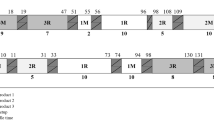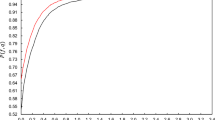Abstract
This paper addresses an economic lot scheduling problem (ELSP) for manufacturing environments regarding slack costs and deteriorating items using the extended basic period approach under Power-of-Two (PoT) policy. The purpose of this research is to determine an optimal batch size for a product and minimizing total related costs to such a problem. The cost function consists of three components, namely, setup cost, holding cost includes deteriorating factor, and slack cost. The ELSP is concerned with the scheduling decision of n items and lot sizing. Avoiding schedule interference is the main problem in ELSP. The used PoT policy ensures that the replenishment cycle of each item to be integer and this task reduces potential schedule interferences. Since the ELSP is shown as an NP-hard problem, an imperialist competitive algorithm is employed to provide good solutions within reasonable computational times. Computational results show that the proposed approach can efficiently solve such complicated problems.
Similar content being viewed by others
References
Abad PL (1996) Optimal pricing and lot-sizing under conditions of perish ability and partial backordering. Manag Sci 42:1093–1104
Abad PL (2000) Optimal lot size for a perishable good under conditions of finite production and partial backordering and lost sale. Comput Ind Eng 38:457–465
Al-Aomar R (2006) Incorporating robustness into genetic algorithm search of stochastic simulation outputs. Simulat Model Pract Theor 14:201–223
Atashpaz E, Lucas C (2007) Imperialist Competitive Algorithm: An Algorithm for Optimization Inspired by Imperialist Competition. 2007 IEEE Congress on Evolutionary Computation (CEC 2007).
Balkhi Z, Benkherouf L (1996) A production lot size inventory model for deteriorating items and arbitrary production and demand rates. Eur J Oper Res 92:302–309
Boesel J, Nelson BL, Ishii N (2003) A framework for simulation-optimization software. IIE Transactions 35:221–229
Bomberger E (1966) A dynamic programming approach to a lot scheduling problem. Manag Sci 12:778–84
Brander P, Segerstedt A (2009) Economic lot scheduling problems incorporating a cost of using the production facility. Int J Prod Res 47:3611–3624
Chatfield DC (2007) The economic lot scheduling problem: a pure genetic search approach. Comput Oper Res 34:2865–2881
Cochran WG, Cox GM (1992) Experimental designs, 2nd edn. Wiley, New York
Cooke DL, Rohleder TR, Silver ED (2004) Finding effective schedules for the economic lot scheduling problem: a simple mixed integer programming approach. Int J Prod Res 42:21–36
Dobson G (1987) The ELSP: achieving feasibility using time-varying lot sizes. Oper Res 35(5):764–71
Eilon S (1958) Economic batch size determination for multiproduct scheduling. Oper Res Q 10:217–277
Elmaghraby SE (1978) The economic lot scheduling problem (ELSP): review and extension. Manag Sci 24:587–597
Elsayed EA, Teresi C (1983) Analysis of inventory system with deteriorating items. Int J Prod Res 21:449–460
Federgruen A, Zheng YS (1993) Optimal power-of-two replenishment strategies in capacitated general production distribution networks. Manag Sci 39:710–727
Gallego G, Joneja D (1994) Economic lot scheduling problem with raw material considerations. Oper Res 42(1):92–101
Ghare PM, Schrader GF (1963) A model for an exponentially decaying inventory. J Ind Eng 14:238–243
Goyal SK (1975) Scheduling a multi-product single machine system—a new approach. Int J Prod Res 13:487–93
Heng KJ, Labban J, Linn RJ (1991) An order-level lot-size inventory model for deteriorating items with finite replenishment rate. Comput Ind Eng 20:187–197
Heydari M, Torabi SA (2008) The economic lot scheduling problem in flow lines with sequence-dependent setups. World Academy of Science Eng Tech 47:2008
Hsu WL (1983) On the general feasibility of scheduling lot sizes of several products on one machine. Manag Sci 29:93–105
Hunter A (1998) Crossing over genetic algorithms: the Sugal generalized GA. Journal of Heuristics 4:179–192
Jackson PL, Maxwell WL, Muckstadt JA (1985) The joint replenishment problem with a power-of-two restriction. IIE Trans 17:25–32
Khabbazi A, Atashpaz E, Lucas C (2009) Imperialist competitive algorithm for minimum bit error rate beamforming. Int J Bio-Inspired Comput 1:125–133
Lopez MA, Kingsman BG (1991) The economic lot scheduling problem: theory and practice. Int J Prod Econ 23:147–164
Luss H, Rosenwein MB (1990) A lot-sizing model for just-in-time manufacturing. J Oper Res Soc 41(3):201–209
Maxwell WL (1964) The scheduling of economic lot sizes. Nav Res Logist Q 11:89–124
Misra RB (1975) Optimal production lot size model for a system with deteriorating items. Int J Prod Res 13:495–505
Montgomery DC (2000) Design and analysis of experiments, 5th edn. Wiley, New York
Moon IK, Cha BC, Bae HC (2006) Hybrid genetic algorithm for group technology economic lot scheduling problem. Int J Prod Res 44:4551–4568
Nahmias S (1978) Perishable inventory theory: a review. Oper Res 30:680–708
Phadke MS (1989) Quality engineering using robust design. Prentice-Hall, Engelwood Cliffs
Pohlheim H (2001) Evolutionary algorithms: principles, methods, and algorithms [online]. Available from: http://www.geatbx.com/index.html, [accessed on 6 May 2004].
Raafat F (1991) Survey of literature on continuously deteriorating inventory models. J Oper Res Soc 42:27–37
Roundy R (1984) Rounding off to powers of two in continuous relaxations of capacitated lot sizing problems. Manag Sci 35:1433–1442
Soman CA, Van Donk DP, Gaalman G (2003) Combined make-to-order and make-to-stock in a food production system. To appear in International Journal of Production Economics, http://dx.doi.org/10.1016/S0925-5273(02)00376-6.
Soman CA, Van Donk DP, Gaalman G (2004) A basic period approach to the economic lot scheduling problem with shelf life considerations. Int J Prod Res 42:1677–1689
Taguchi G (1986) Introduction to quality engineering. Asian Productivity, White Plains
Tsai JT, Ho WH, Liu TK, Chou JH (2007) Improved immune algorithm for global numerical optimisation and job-shop scheduling problems. Appl Math Comput 194:406–424
Yao MJ, Elmaghraby SE (2001) The economic lot scheduling problem under power-of-two policy. Comput Math Appl (CMWA) 41:1379–1393
Yao MJ, Elmaghraby SE, Chen IC (2003) On the feasibility testing of the economic lot scheduling problem using the extended basic period approach. J Chin Inst Ind Eng 20:435–448
Yao MJ, Huang JX (2005) Solving the economic lot scheduling problem with deteriorating items using genetic algorithms. J Food Eng 70:309–322
Author information
Authors and Affiliations
Corresponding author
Rights and permissions
About this article
Cite this article
Kayvanfar, V., Zandieh, M. The economic lot scheduling problem with deteriorating items and shortage: an imperialist competitive algorithm. Int J Adv Manuf Technol 62, 759–773 (2012). https://doi.org/10.1007/s00170-011-3820-6
Received:
Accepted:
Published:
Issue Date:
DOI: https://doi.org/10.1007/s00170-011-3820-6




